Espoo’s climate goals
It is Espoo’s goal to reach climate neutrality by 2030. Climate neutrality means that the city emits only as much greenhouse gas emissions per year as it can absorb. The Climate-neutral Espoo 2030 roadmap is a compilation of the cooperation between the City of Espoo and its partners and residents as well as concrete measures used to achieve the goal of climate neutrality. The Climate Watch service allows you to follow how the city is progressing in implementing its climate action.
Espoo has defined as its climate neutrality goal an 80% emission reduction from the 1990 level by the year 2030. The remaining 20% share can be absorbed in carbon sinks or compensated by other means. Carbon sink is a term used to refer to growing carbon stocks, such as growing forests. Compensation refers to emission reduction units procured from outside the city organisation’s own activities to compensate for the remaining greenhouse gas emissions.
Climate emissions generated in Espoo have decreased by 33 per cent since 1990. Emissions per capita have decreased by 64 per cent and are the lowest in the capital region for the eighth consecutive year. Read more: Climate emissions decrease despite population growth – Espoo’s emissions continue to decline.
Espoo will achieve climate neutrality by 2030
- "Espoo will actively combat climate change, strengthen biodiversity and achieve climate neutrality by 2030."
- "Espoo will adapt to the impacts of climate change."
- "Cooperation with universities, research organisations, innovation activities and businesses will generate solutions with a significant carbon handprint that will help tackle the global climate challenge."
- "A roadmap for combating climate change will be drawn up for the city to describe the City of Espoo’s own activities and the cooperation with partners and residents to achieve the goal of climate neutrality."
Land use

Land use has a cross-sectional effect on all the focal points of the climate roadmap. The foundation for carbon-neutral solutions is laid by good land use planning. The main outlines for the whole of Espoo will be set out in the Espoo Master Plan 2060, which is currently being prepared, and more detailed guidelines will be given in the city plan.
Land use planning has a significant impact on emissions from energy, transport and construction. Land use planning is used to influence issues such as traffic performances and the proportion of means of transport, the implementation of emission-free energy solutions, low-carbon construction, sufficient carbon sinks and stocks as well as an accessible living environment. Espoo’s city planning projects include carrying out assessments of climate impacts.
See Land use, pages 29–30, in the Carbon-neutral Espoo 2030 roadmap.
Read more: Climate-smart city planning I City of Espoo
Elina Kuusisto,
planning manager
city planning department, urban environment sector
elina.kuusisto@espoo.fi
Liisa Ikonen
planning manager
city planning department, urban environment sector
liisa.ikonen@espoo.fi
Emmi Kauhanen
development manager
strategy and development, mayor's office
emmi.kauhanen@espoo.fi
Read more: City planning I City of Espoo
Energy

Espoo is building an intelligently controlled energy system that will provide the residents and businesses with emission-free and affordable energy. The carbon footprint of the energy sector is reduced by increasing sustainable energy production and reducing consumption.
Together with energy company Fortum, we are committed to achieving carbon-neutral district heat. Other measures to increase renewable and carbon-neutral energy, such as phasing out oil heat and investing in solar panels, are also part of the effort to cut down the city’s climate emissions.
Rapid electrification and the development of the electricity grid will accelerate emission reductions in both district heat and transport and enable several carbon-neutrality actions in the energy sector. In the production, consumption and distribution of energy, new operating models are applied, which lead to equalising consumption peaks and saving energy. We are investing in raising energy awareness.
The objective of the Espoo Clean Heat programme is to produce all district heat in the areas of Espoo, Kauniainen and Kirkkonummi in a carbon-neutral manner during the 2020s. The district heating network provides heat to some 250,000 end users in homes and offices. The use of coal ceased in April 2024.
See Energy use, pages 33–46, in the Carbon-neutral Espoo 2030 roadmap.
Read more: Espoo Clean Heat(external link, opens in a new window)
Read more: Energy and electricity I City of Espoo
A systematic entity of energy production, distribution and usage is being implemented in Espoo. The goal is a comprehensive energy system. In the future, carbon-neutral district heat will be produced using waste heat and renewable electricity as well as renewable energy sources.
Energy production will become even more part of the cityscape for example, through investments in solar panels and more dispersed production of district heat. Both short- and long-term storage solutions will be developed to enable the most efficient use of renewable electricity and waste heat. New dispersed solutions and technologies will be visible as part of city planning and regional development.
The new operating models will bring residents to the energy market as active participants, and Espoo’s pioneering solutions will create national and international business for local companies.
See Energy, pages 33–46, in the Carbon-neutral Espoo 2030 roadmap.
Read more: Energy and electricity I City of Espoo
| Residents | Housing companies | Companies in the energy sector | Caruna | Fortum |
| Property owners | Organizations | Companies in the real estate and construction sector | Ministry of Economic Affairs and Employment | VVT |
| Aalto University and other educational institutions | Startup and growth company ecosystems | Helsinki Region Environmental Services (HSY) | Ministry of the Environment |
Espoo’s strength is its open, active and inclusive collaboration with the best partners. New actors are welcome to join the cooperation. Espoo is a European leader in climate work and contributes to the mission 100 Climate-Neutral and Smart Cities by 2030. New partners are invited to join the implementation of experiments, solutions and new operating models that support Espoo’s climate goals.
Join Espoo’s climate partners! Espoo's climate cooperation
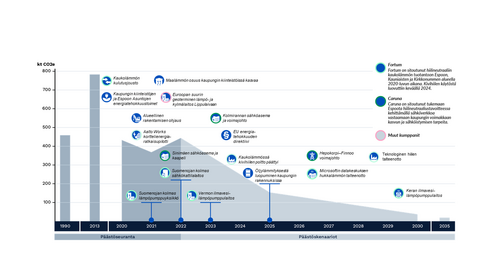
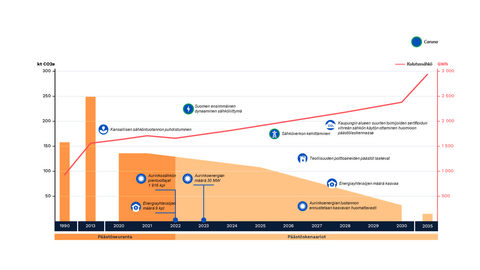
Elina Wanne
development manager
strategy and development, mayor's office
elina.wanne@espoo.fi
Mika Huttunen
energy engineer
city planning department, urban environment sector
mika.huttunen@espoo.fi
Read more: Energy and Electricity | City of Espoo
Transport and mobility

The aim is to reduce overall transport emissions in Espoo. Solutions are being sought for transport and transport infrastructure throughout the city area. This requires both increasing the share of sustainable means of transport and transitioning from fossil-based to non-fossil-based fuels. Efforts will be reflected, for example, in improvements to public transport, walking and cycling conditions and in private car use, especially as a rapid increase in the use of electric cars. The goal is to enable all Espoo residents to move smoothly and with low emissions.
Cooperation will enable the sustainability of the electricity grid as transport becomes more electrified. Biofuels are a transport sub-solution. Circular economy models will bring solutions to the development work. Companies in Espoo are developing new power sources and automated transport, especially for freight transport.
See Traffic, pages 47–62, in the Carbon-neutral Espoo 2030 roadmap.
In Espoo, emissions from traffic are a significant challenge as the population increases. In order to achieve the carbon neutrality objective, it is important to implement the planned measures to reduce traffic volumes and unit emissions.
The Espoo Master Plan 2060 will set out the important outlines for the development of public transport in the joint planning of land use and transport. In addition, regional cooperation and development work with companies, other cities and research institutes is being carried out with regard to transport.
Walking and cycling complement public transport and increase the comfort of urban centres. Espoo’s public transport has been developed through the extension of the West Metro and the Jokeri Light Rail. The number of electric cars and electric vehicles in Espoo is growing. The range of methods for optimizing logistics and emission-free power sources will be developed in cooperation with businesses and operators in the region.
See Traffic, pages 47–62, in the Carbon-neutral Espoo 2030 roadmap.
| Organizations | Companies | Helsinki Regional Transport (HSL) | Uusimaa ELY Centre | Aalto University and other educational institutions |
| VVT | Ministry of Transport and Communications | Helsinki-Uusimaa Regional Council | Companies developing the charging infrastructure and services | ITS Finland |
| Startup and growth companies ecosystem | Transport services | Other cities and municipalities |
Espoo’s strength is its open, active and inclusive collaboration with the best partners. New actors are welcome to join the cooperation. Espoo is a European leader in climate work and contributes to the mission 100 Climate-Neutral and Smart Cities by 2030. New partners are invited to join the implementation of experiments, solutions and new operating models that support Espoo’s climate goals.
Join Espoo’s climate partners! Espoo's climate cooperation
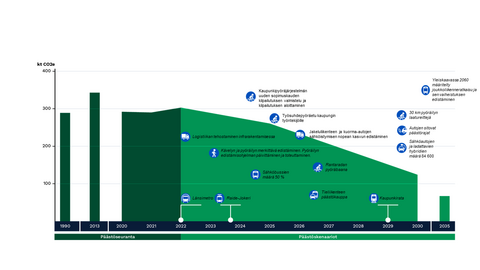
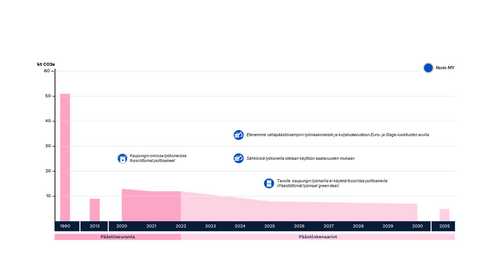
Mari Päätalo
development manager
strategy and development, mayor's office
mari.paatalo@espoo.fi
Susanna Kaitanen
traffic planning manager
city planning department, urban environment sector
susanna.kaitanen@espoo.fi
Pauliina Kuronen
city transport manager
public works department, urban environment sector
pauliina.kuronen@espoo.fi
Read more: Transport and mobility I City of Espoo
Read more: Transport and streets I City of Espoo
Construction

Espoo is planning and building along good public transport connections, in a sustainable and environmentally-friendly way. The aim is to reduce emissions and other environmental impacts throughout the entire lifecycle of construction.
Espoo controls construction through land use control measures and also builds itself. Espoo promotes low-carbon, comprehensively sustainable and resource-wise solutions and the circular economy both in its construction steering and in its own construction. The climate impacts of construction are taken into account, and emissions are strongly reduced through cooperation between the city group and partners. Espoo wants to be a pioneer in the EU in the transition to low-carbon building stock.
See Construction, pages 63–72, in the Carbon-neutral Espoo 2030 roadmap.
The new Construction Act, which will enter into force in 2025, will introduce a number of obligations to promote low-carbon and circular economy. These include the calculation of the carbon footprint of buildings and emission limit values for buildings, the preparation of a material passport and specification, the making of a demolition survey mandatory for all demolition sites, the digitalisation of building information and a data model-based building permit.
In addition to legislation, factors such as global resource shortages, rising costs and housing trends affect the future and the practical solutions and needs of construction and encourage more effective circular economy solutions. Changes in legislation and the operating environment will require resources and the development of steering instruments and skills.
Espoo plans new areas in accordance with the principles of sustainable development, including promoting the circular economy of infrastructure construction, utilising emission calculation in regional construction, promoting low-carbon construction in city planning, and developing innovative incentives for promoting sustainability.
See Construction, pages 63–72, in the Carbon-neutral Espoo 2030 roadmap.
| Educational institutes | RDI operators | Startups and growth companies |
| Ministry of the Environment | Property owners | Organizations |
| Municipalities in the Metropolitan Area | Companies in the real estate and construction sector | Topten cooperation in the construction sector |
Espoo’s strength is its open, active and inclusive collaboration with the best partners. New actors are welcome to join the cooperation. Espoo is a European leader in climate work and contributes to the mission 100 Climate-Neutral and Smart Cities by 2030. New partners are invited to join the implementation of experiments, solutions and new operating models that support Espoo’s climate goals.
Join Espoo’s climate partners! Espoo's climate cooperation
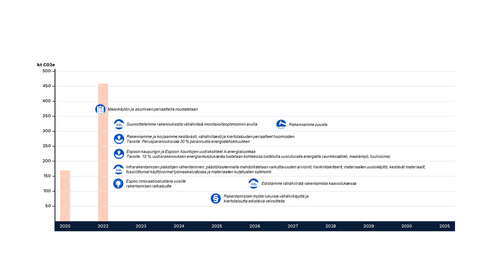
Emmi Kauhanen
development manager
strategy and development, mayor's office
emmi.kauhanen@espoo.fi
Read more: Building I City of Espoo
Circular economy

Espoo strives to be a carbon-neutral city with a circular economy. In Espoo, circular economy helps to curb overconsumption of natural resources, generation of waste as well as climate change. It also helps protect biodiversity. Circular economy solutions reduce emissions across all the priorities of the climate roadmap.
The circular economy improves the quality of life in Espoo. Taking the circular economy into account is an increasingly strong part of the city’s decision-making and operations in all urban solutions. We invest in circular economy communications and education, and waste sorting is improved in city-owned properties.
In Espoo, the areas of Kera and Kiviruukki, in particular, function as circular economy development areas. Business operations based on the circular economy create sustainable economic growth and structures for a sustainable lifestyle.
See Circular economy, pages 73–84, in the Carbon-neutral Espoo 2030 roadmap.
See also:
Espoo has signed a green deal for emission-free construction sites – a sustainable procurement agreement that aims to reduce carbon dioxide emissions, harmful exhaust emissions and noise from the city’s construction sites. This agreement provides concrete methods and tools with which Espoo can promote its own carbon neutrality goals. The aim of the agreement is to ensure that no fossil fuels are used on the city’s construction sites after 2025.
Espoo is committed to the Europe-wide circular economy commitment Circular Cities Declaration, the ten goals of which promote the implementation of the city’s circular economy and sustainable development. The circular economy commitment supports Espoo’s goal of becoming carbon-neutral by 2030 and achieving the UN’s Sustainable Development Goals as a pioneer city.
Espoo is at the forefront of circular economy development. The goal is a systemic transition to a fair circular economy.
In the future, the City of Espoo will support the circular economy through its decisions and actions by removing barriers to growth, strengthening enabling structures, increasing competence and research and development operations and highlighting examples of infrastructure solutions, procurements and investments. Espoo’s rapid population growth and dense urbanisation will create increasing business opportunities for the circular and sharing economy, through reuse, material recycling and various rental and sharing services. However, the circulation of materials also requires areas for intermediate storage and recycling, the placement of which is challenging in the increasingly more densely built urban structure. Residents’ everyday decisions will reduce climate emissions from consumption in Espoo.
See Circular economy, pages 73–84, in the Carbon-neutral Espoo 2030 roadmap.
| Circular and sharing economy companies of different sizes | Educational and research institutions | Helsinki Region Environmental Services (HSY) |
| Helsinki-Uusimaa Regional Council | Ministry of the Environment | Landowners and operators in the development areas |
Espoo’s strength is its open, active and inclusive collaboration with the best partners. New actors are welcome to join the cooperation. Espoo is a European leader in climate work and contributes to the mission 100 Climate-Neutral and Smart Cities by 2030. New partners are invited to join the implementation of experiments, solutions and new operating models that support Espoo’s climate goals.
Join Espoo’s climate partners! Espoo's climate cooperation
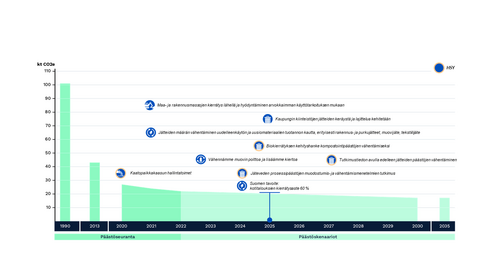
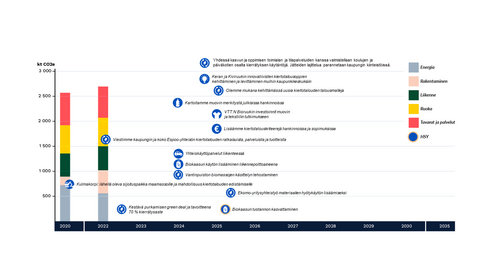
Reetta Jänis
development manager
strategy and development, mayor's office
reetta.janis@espoo.fi
Read more: Carbon-neutral circular economy I City of Espoo
Sustainable lifestyle

Every Espoo resident will be guaranteed opportunities for a sustainable lifestyle. We promote change by inspiring and supporting Espoo residents to make sustainable choices in their everyday lives, and by helping businesses, organisations and other partners to find their own ways to accelerate the transition to sustainable lifestyles.
Espoo will influence the consumption emissions of Espoo residents through its operations such as education, communication, construction, land use management and food services. Espoo’s actions will also have an indirect impact on the choices of households in terms of mobility, energy, food and acquisitions. Sustainable solutions will be created without compromising the well-being and smoothness of everyday life of Espoo residents.
See Sustainable lifestyle, pages 85–92, in the Carbon-neutral Espoo 2030 roadmap.
The city’s role in supporting the transition to a sustainable lifestyle is to be an active enabler, service provider, partner and communicator. Cooperation with different communities and organizations is key to reaching as many Espoo residents as possible.
Sustainable lifestyle options emphasise the use of services rather than ownership, the diverse use of facilities, the reduction of waste, the mainstreaming of reuse and the consideration of the resale value of a product at the point of purchase. Sharing, lending and renting promote a sense of community, social good and economic opportunity for all to live a sustainable lifestyle. Sustainable digitality and the addition of remote services will reduce emissions, enable effective services and save costs.
See Sustainable lifestyle, pages 85–92, in the Carbon-neutral Espoo 2030 roadmap.
| Residents and residents’ associations | Helsinki Regional Transport (HSL) | Helsinki Region Environmental Services (HSY) |
| Research and educational institutions | Companies of different sizes providing circular and sharing economy services | Organisations and the third sector |
Espoo’s strength is its open, active and inclusive collaboration with the best partners. New actors are welcome to join the cooperation. Espoo is a European leader in climate work and contributes to the mission 100 Climate-Neutral and Smart Cities by 2030. New partners are invited to join the implementation of experiments, solutions and new operating models that support Espoo’s climate goals.
Join Espoo’s climate partners! Espoo's climate cooperation

Reetta Jänis
development manager
strategy and development, mayor's office
reetta.janis@espoo.fi
Carbon sinks

Carbon sinks refer to growing carbon stocks, such as forest growth. Espoo has defined as its carbon neutrality goal an 80% emission reduction from the 1990 level by the year 2030. The aim is that the remaining 20% can be either absorbed by carbon sinks or offset. Reducing emissions and having natural carbon sinks are the primary means of mitigating climate change. Espoo aims to support the goals of the Finnish state concerning carbon sinks by securing carbon sinks.
The knowledge base on the amount and development of carbon sinks is constantly being refined, and Espoo is actively involved in the development work. Carbon sinks are considered in land use planning as part of efforts such as the Espoo Master Plan 2060. Carbon sink issues are also a relevant part of our climate cooperation with our corporate partners.
Technical carbon sinks, such as carbon capture and storage technologies, can be used to complement natural carbon sinks to ensure that the city’s carbon-neutrality objective is achieved. The development of technical sinks is promoted by many research institutes and companies in the Espoo community.
See Carbon sinks, pages 93–96, in the Carbon-neutral Espoo 2030 roadmap.
The joint carbon sink mapping (link) of the Helsinki Region Environmental Services HSY and municipalities in the Helsinki Metropolitan Area, which was published in February 2021, provides the cities with a precise and up-to-date picture of the carbon storages of soil and vegetation, as well as how they are increasing i.e. becoming carbon sinks. The largest carbon stocks and sinks are found in forest soils and vegetation. At the time of preparing this material, Espoo’s carbon sinks are so large that they could offset greenhouse gas emissions in 2030 if the emissions can be reduced by the targeted 80% compared to 1990. City planning solutions can be used to determine how Espoo’s carbon sinks will develop in the future.
More information: Carbon sink mapping of Helsinki Metropolitan Area:(external link, opens in a new window)
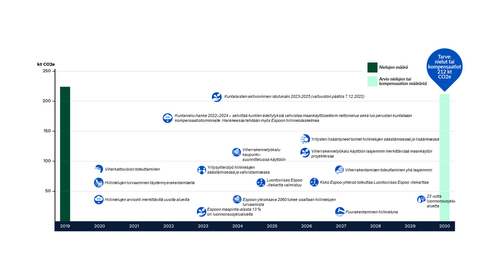
Anna Ikonen
environment specialist
environment and building control department, urban environment sector
anna.ikonen@espoo.fi
Paula Kuusisto-Hjort
planning manager
city planning department, urban environment sector
paula.kuusisto-hjort@espoo.fi
Adaptation

Adapting to climate change refers to the means and ways that can be used to prepare for the effects of climate change and reduce the vulnerability of society and the environment to them. Adaptation measures promote the functional capacity of people, society and the environment.
Espoo’s action plan for adaptation to climate change 2022–2025 describes the ways and means that Espoo will use to prepare for the impacts of climate change and reduce the vulnerability of society and the environment.
More information: Espoo’s action plan for adaptation to climate change 2022–2025(external link, opens in a new window)
Read more: Climate change adaptation I City of Espoo
See Adaptation, page 101, in the Carbon-neutral Espoo 2030 roadmap.
Nature-wise Espoo

Espoo aims to take care of biodiversity as the city grows and develops. Through Nature-Wise Espoo work, we secure and increase biodiversity in Espoo increasingly better. We will compile Espoo’s objectives and development measures into a roadmap, which will be published in 2024.
Read more: Nature-wise Espoo
See Nature-wise Espoo, page 101, in the Carbon-neutral Espoo 2030 roadmap.
Paula Kuusisto-Hjort
planning manager
city planning department, urban environment sector
paula.kuusisto-hjort@espoo.fi
Marika Rönnberg
environment specialist
environment and building control department, urban environment sector
marika.ronnberg@espoo.fi
Implementation of Carbon-neutral Espoo 2030 roadmap

The Espoo Story, or the City’s strategy, guides the activities of the city according to common goals. One of the goals is achieving carbon neutrality by 2030.
The Mayor’s Office of the City of Espoo is responsible for promoting and steering climate work at city level. The sustainable development and climate work steering group supports the Mayor’s management work. The sectors, profit centres and group companies are responsible for implementing the measures in their areas of responsibility in accordance with the directives and group guidelines.
The cross-administrative Sustainable Espoo development programme seeks, in cooperation with various partners, solutions to climate challenges with the support of external funding.
Espoo is part of the EU Mission for 100 Climate-Neutral and Smart Cities in which selected cities, together with their stakeholders, prepare a Climate City Contract (CCC).
Espoo also involved in the Covenant of Mayors and has compiled a Sustainable Energy and Climate Action Plan (SECAP) in 2019.
In addition, its operations are guided by various sector-specific agreements and programmes, such as the Energy Efficiency Agreement for Municipal Sector (KETS) and the Energy Efficiency Agreements for Rental Housing (VAETS). 1)
Achievement of the climate goal will be monitored as part of the monitoring of the Espoo Story objectives for the council term. Every year, binding city-level performance targets are derived from the Espoo Story, i.e. the city’s strategy. New climate measures are decided every year as part of the budget. The Climate Watch will present in detail all significant climate measures in Espoo.
See Implementation, pages 9, 10 and 104, in the Carbon-neutral Espoo 2030 roadmap.
Espoo City Council unanimously approved the Climate Neutral Espoo 2030 Roadmap on 20.5.2024.
City Council minutes of 20.5.2024 Dynasty information service(external link, opens in a new window) (in Finnish).
Espoo.fi -news article 21.5.2024. Espoo decided on a roadmap to achieve carbon neutrality.
Downloadable files
- Hiilineutraali Espoo 2030 -tiekartta JAETTUFile is only available in Finnish
- Climate Neutral Espoo 2030 Roadmap
